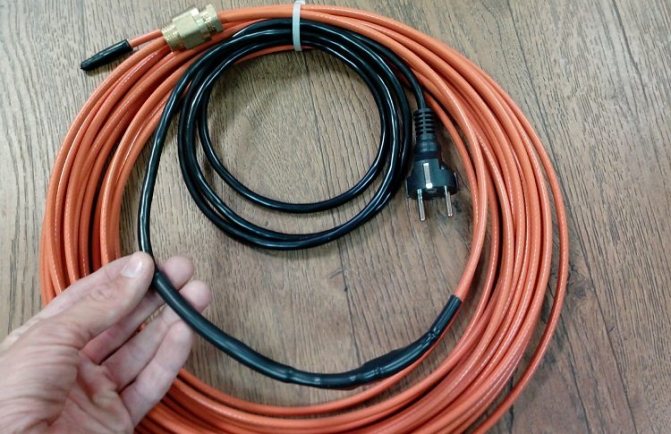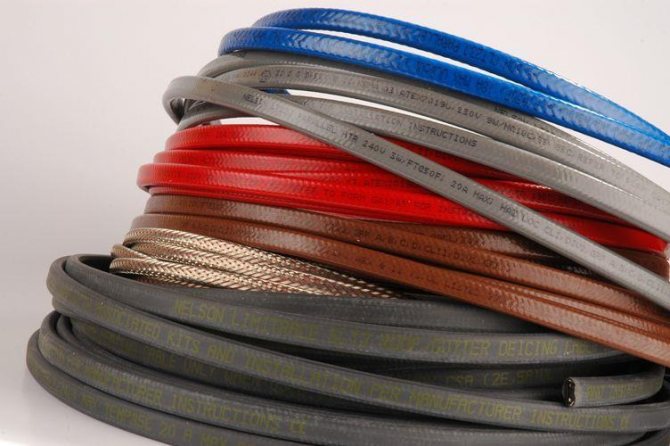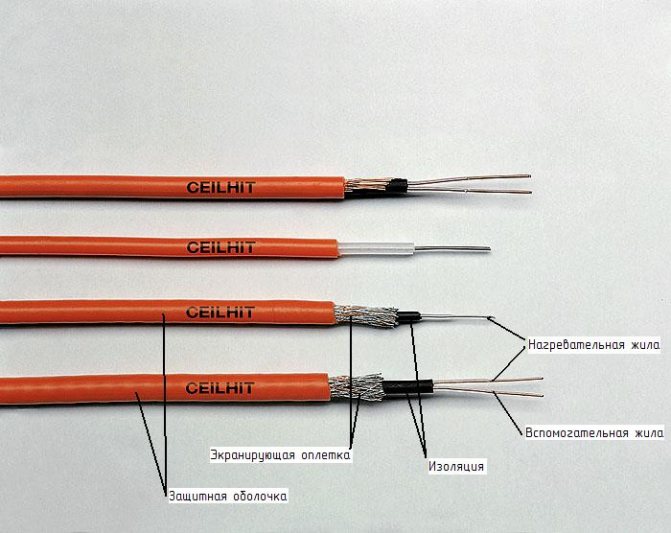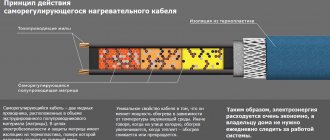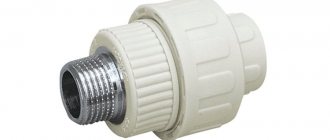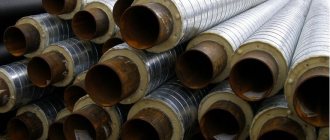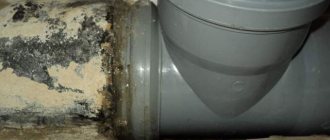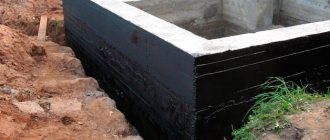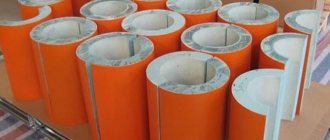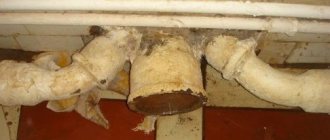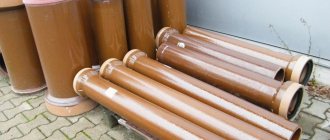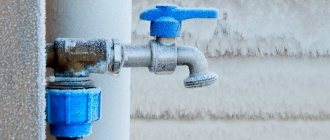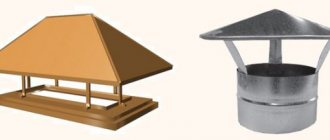Deepening the external sewage system deeper than the level of soil freezing is a troublesome job, especially if the work is carried out in winter. An alternative option for frost protection is a heating cable for sewer pipes. It's worth familiarizing yourself with the peculiarities of its styling, don't you agree?
From the article we have proposed, you will learn everything about the device for cable heating of the sewer pipeline. We will tell you how a heating cable works and how to choose the best option correctly. For independent owners, there is a step-by-step installation and fastening guide.
Why does the sewer freeze?
The problem of freezing of the sewer pipe is not immediately detected. Unlike water pipelines, here the flow of liquid is not constant and does not completely fill the cross-section of the pipe.
In addition, sewage entering the sewer system usually has a higher temperature than, for example, water from a well. Therefore, the freezing of effluents occurs gradually.
At first, only a small part of the contents of the sewer can freeze, then another layer of frozen sewage appears, etc. Gradually, the entire lumen of the pipe is filled with a dense frozen mass, after which the problem becomes obvious. Faulty plumbing, such as a leaking faucet or cistern, can aggravate the problem.
Small portions of water enter the sewer system, quickly cool and freeze. Even the correct laying of sewer pipes and the presence of a layer of insulation do not always prevent the drains from freezing. Defrosting frozen sewers is troublesome, in addition, this phenomenon can lead to damage to pipes, some of which will have to be replaced.
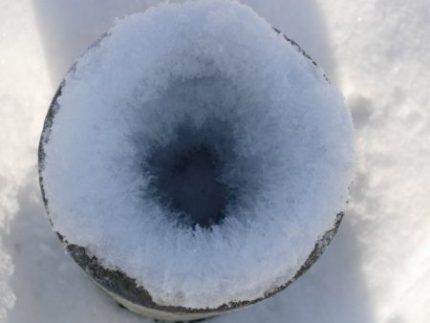
Freezing of a sewer pipe can occur gradually, layer by layer, and a little leaking plumbing only increases the danger of this unpleasant phenomenon
Therefore, it is recommended to lay the sewage system below the level of freezing of the soil with the obligatory insulation of communications. If in the southern regions and the middle lane digging a sufficiently deep trench is usually not a problem, then in the north everything is a little more complicated. In this situation, the use of a special heating or hot cable is more than appropriate.
When using this type of system, the amount of earthwork is noticeably reduced, since the depth of the trench can be reduced to an acceptable level without worrying about freezing the soil.
Can a sewer freeze?
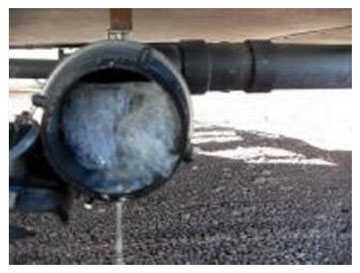

The situation with the freezing of the sewer pipe is quite rare, because such a pipe has a slope from the consumer device, therefore, unlike a water pipe, it is empty most of the time, and portions of liquids periodically flowing through it are usually. lukewarm. However, if small water leaks occur due to a malfunction of the drain unit in the toilet bowl or due to a leaking tap, then the water does not have time fast
walk to a warm septic tank and freezes along the way.
Such leaks freeze layer by layer and eventually completely overlap the diameter of the sewer pipe.
In order to remove the ice plug, you need to melt it with boiling water and salt, or dig out the pipe and try to warm it up with a blowtorch or a hair dryer. After removing the ice plug, it is necessary to check the pipeline for cracks, and, if necessary, replace the damaged section.
How does a heating cable work?
A heating or hot cable is a heating system for pipes laid in the soil.An electric cable in an insulating sheath is fixed to the pipe and connected to the power supply. The pipe heats up, as a result, the wastewater acquires a consistently high temperature, which reliably protects it from freezing.
A distinction is made between a cable for external heating of a pipe or an internal one. The first is laid outside the structure, and the second inside. It is believed that outdoor installation is easier than indoor installation, so it is more in demand. In addition to the outer cable, a heating film is also used.
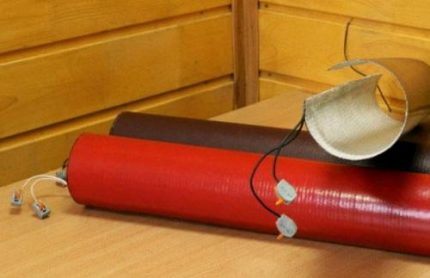

Heating with a film for sewer systems is not often used. The material has to be wrapped around the entire pipe, which complicates the installation, but ensures uniform heating
The structure is completely wrapped with this material, then it is fixed. The film provides a more uniform heating of the pipe than the cable, it has a lower power, which makes it possible to somewhat reduce operating costs.
Three types of cable can be used to heat pipes:
- self-regulating;
- resistive;
- zonal.
A self-regulating cable is considered an extremely convenient option, since it can automatically change the heating temperature depending on climatic conditions. The cable resistance decreases as the soil heats up more and increases as the temperature drops.
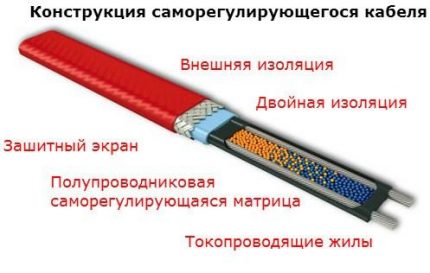

Self-regulating cable is most in demand in modern conditions, since it is easy to lay it, it is more reliable and does not require additional elements for installation
This change in operating mode reduces the overall system power, i. E. allows you to save energy. Moreover, the change in resistance can be different in certain sections of the pipeline. The result is a higher quality of heating, the self-regulating cable itself will last longer, and there is no need to install thermostats.
A resistive cable does not possess such capabilities, but differs in comparison with self-regulating systems at a more moderate price. When installing this type of cable, you will need to install a set of temperature sensors and thermostats to ensure that the system's operating mode changes when the weather changes.
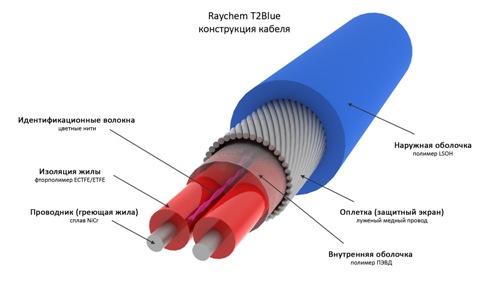

Resistive cable costs less than self-regulating counterparts. If this option is selected, a suitable power density must be carefully calculated to prevent overheating.
If this requirement is neglected, the risk of cable overheating and breakage increases. The zone cable also does not have the ability to regulate the resistance, but this system does not generate heat along the entire length, but only in certain sections. Such a cable can be cut into separate fragments, which is convenient when installing pipelines of complex configuration.
It is also widely used in the installation of metal sewers or for heating tanks. It should be noted that heating structures buried in the ground is not the only area of using the heating cable. It is also used to heat pipes laid on the surface or in rooms that are not heated.
Sometimes the cable is used only for certain sections of the pipeline, for example, parts that come to the surface. Systems that are mounted inside a pipe are relatively rarely used. They are most often used if the pipeline has already been laid in the ground and the installation of the external cable would require extensive earthwork.
So the installation of the internal cable will be much cheaper. But such cables are usually recommended to be used only inside small-diameter pipes, since they have low power.
It varies in the range of 9-13 W / m, which is usually not enough for large sewer pipes. The length of such a cable, for obvious reasons, should be equal to the length of the pipe. The internal heating cable is manufactured only of the self-regulating type.
An example of a heated sewerage device
Consider an example of constructing a sewerage system for a private household. According to the project, several branches are connected to the common sewer main. All of them are laid above the horizon of seasonal soil freezing, therefore they are supplied with a heating cable.
In order for the operation of the heating electrical system to be effective and aimed directly at maintaining the positive temperature of the sewer pipe, communications are laid in an insulated trench:
In the case when it is not possible to lay the pipe below the level of soil freezing, it becomes necessary to heat the sewer pipes. In addition, quite often, on the sites of country houses, it is necessary to lay communications over the ground. How to lay heated sewer pipes will be discussed in this article.
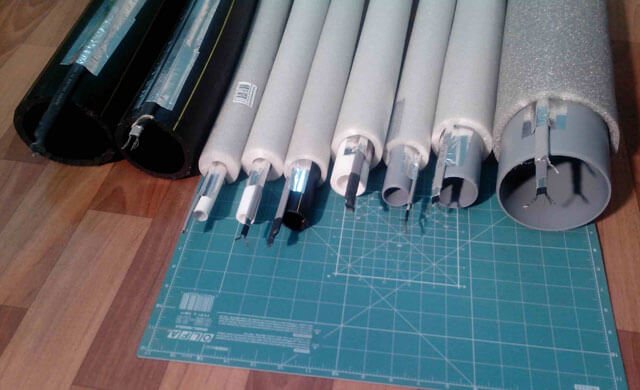

How to find the right cable?
When choosing a suitable hot cable, it is necessary to decide not only on its type, but also to choose the right power for it.
In this case, it is necessary to take into account such parameters as:
- the purpose of the structure (for sewerage and water supply, calculations are performed in different ways);
- the material from which the sewerage is made;
- pipeline diameter;
- features of the site that is supposed to be heated;
- characteristic of the used thermal insulation material.
Based on this information, heat loss is calculated for each meter of the structure, the type of cable, its power is selected, and then the appropriate length of the kit is determined. Calculations can be performed using a special formula, according to calculation tables or using an online calculator.
The calculation formula looks like this:
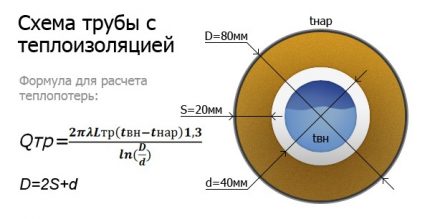

Qtr - pipe heat loss (W); - coefficient of thermal conductivity of the insulation; Ltr - the length of the heated pipe (m); tвн - temperature of the contents of the pipe (C), tout - minimum ambient temperature (C); D is the outer diameter of the communications, taking into account the insulation (m); d - outer diameter of communications (m); 1.3 - safety factor
When the heat loss has been calculated, the length of the system should be calculated. To do this, the resulting value must be divided by the specific power of the heating device cable. The result should be increased, taking into account the heating of additional elements. The power of the sewer cable starts from 17 W / m and can exceed 30 W / m.
If we are talking about sewer pipelines made of polyethylene and PVC, then 17 W / m is the maximum power. If you use a more efficient cable, then there is a high probability of overheating and damage to the pipe. Information on the characteristics of the product can be found in its data sheet.
Using the table, choosing the right option is a little easier. To do this, you first need to find out the diameter of the pipe and the thickness of the insulation, as well as the estimated difference between the temperature of the air and the contents of the pipeline. The latter indicator can be found using reference data depending on the region.
At the intersection of the corresponding row and column, you can find the value of heat loss per meter of pipe. Then the total cable length should be calculated. To do this, the size of the specific heat loss, obtained from the table, must be multiplied by the length of the pipeline and by a factor of 1.3.
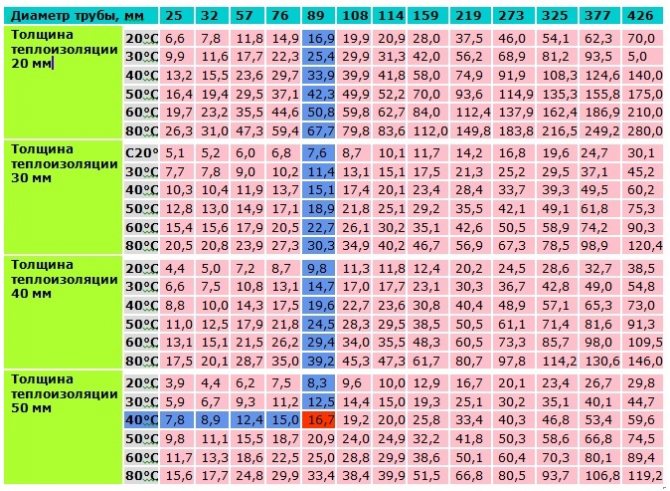

The table allows you to find the size of the specific heat loss of a pipe of a specific diameter, taking into account the thickness of the heat-insulating material and the operating conditions of the pipeline (+)
The result obtained should be divided by the power density of the cable. Then you need to take into account the influence of additional elements, if any. Convenient online calculators can be found on specialized sites. In the appropriate fields, you need to enter the necessary data, for example, the diameter of the pipes, the thickness of the insulation, the temperature of the ambient and working fluid, the region, etc.
Such programs usually offer the user additional options, for example, they help to calculate the required diameter of the sewer, the dimensions of the thermal insulation layer, the type of insulation, etc.
Optionally, you can select the type of installation, find out the appropriate step when installing the heating cable with a spiral, get a list and the number of components that will be needed for laying the system.
When choosing a self-regulating cable, it is important to correctly take into account the diameter of the structure on which it will be installed. For example, for pipes with a diameter of 110 mm, it is recommended to take the Lavita GWS30-2 brand or a similar version of another manufacturer. For a 50 mm pipe, the Lavita GWS24-2 cable is suitable, for structures with a diameter of 32 mm - Lavita GWS16-2, etc.
Complex calculations will not be needed for a sewage system that is not often used, for example, in a summer cottage or in a house that is used only occasionally. In such a situation, they simply take a cable with a power of 17 W / m with a length corresponding to the dimensions of the pipe. A cable of this power can be used both outside and inside the pipe, and it is not necessary to install a gland.
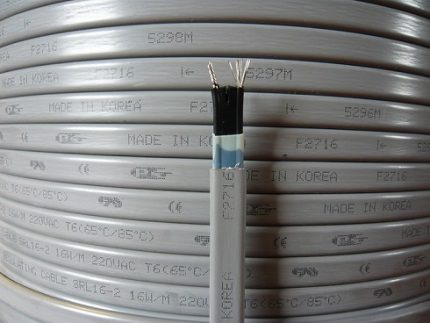

When choosing a suitable option for a heating cable, its performance should be correlated with the calculated data for the probable heat loss of the sewer pipe
For laying the heating cable inside the pipe, choose a cable with special protection against aggressive effects, for example, DVU-13. In some cases, the Lavita RGS 30-2CR brand is used for installation inside. This is not entirely correct, but a valid solution.
Such a cable is intended for heating a roof or storm sewer, therefore, it is not equipped with protection against corrosive substances. It can be considered only as a temporary option, since if used for a long time in unsuitable conditions, the Lavita RGS 30-2CR cable will inevitably break.
Cable heating of sewerage
In turn heating the sewer pipe with a heating cable
prevents such problems from occurring and increases the service life of the sewer system in your home.
The power of the heating cable is selected in such a way as to compensate for the heat loss of the pipe by 120-160% at the minimum temperature according to MSN 2.04-01-98 "Construction climatology":
| Rostov-on-Don | -29 ° C |
| St. Petersburg | -33 ° C |
| Moscow | -36 ° C |
| Yekaterinburg | -42 ° C |
| Yakutsk | -59 ° C |
Considering that in most cases, pipes with an inner diameter of 5 to 110 mm
and thermal insulation with a thickness of 20-50 mm (PPS, PPU, PPE), to solve the problem of protecting sewer pipes from freezing, you can use
self-regulating
heating cables of low temperature class with a linear power from 16 W / m to 32 W / m.
Deepening the external sewage system deeper than the level of soil freezing is a troublesome job, especially if the work is carried out in winter. An alternative option for frost protection is a heating cable for sewer pipes. It's worth familiarizing yourself with the peculiarities of its styling, don't you agree?
From the article we have proposed, you will learn everything about the device for cable heating of the sewer pipeline. We will tell you how a heating cable works and how to choose the best option correctly. For independent owners, a step-by-step installation and fastening guide is provided.
Rules for installing cable on pipes
Heating cable installation is a relatively straightforward process. It is simply fixed to the surface of the pipe, usually lengthwise, in one strip. Separate projects include spiral mounting. In this case, it is necessary to accurately maintain the calculated pitch between the turns of the spiral so that the pipe warms up evenly.
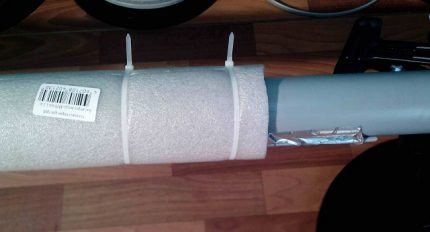

After the heating cable is fixed to the sewer pipe, it is recommended to additionally install a layer of thermal insulation in order to improve the quality of heating.
The intersection of individual sections of the heating cable is not allowed. The cable, depending on the type, is fixed with heat-resistant adhesive tape or mounting ties. The distance between the attachment points must be at least 200 mm. To fix the cable in a mineral sheath, metal fasteners are used: tightening tapes or a special bandage.
But most often I still use heat-resistant tape. Fasteners must withstand not only high temperatures, but also be resistant to the influence of natural factors and chemicals. Sometimes aluminum tape is used as an attachment. But in the places of attachment, the thermal power of the cable will increase.
This is not always useful, it can lead to overheating of communications. It is not recommended to use metal fasteners when installing a heating cable enclosed in a polymeric insulating sheath. But in some cases, aluminum tape can even improve the situation.
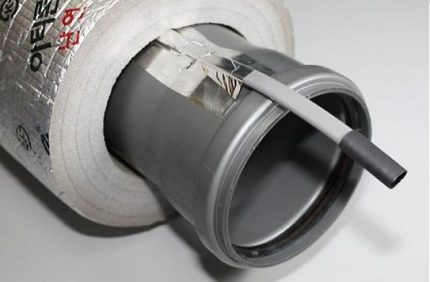

The heating cable on a plastic sewer pipe can be secured with aluminum tape to increase the heating efficiency and make it more uniform
When laying on a polymer pipe, metallized tape is placed both under the cable and above it. This slightly increases the heat output, and also contributes to uniform heating of the pipeline. Inside the sewer, the heating cable is rarely used.
Usually, small areas of the system that are not in the ground are heated in this way, for example, sewer pumps that stimulate the movement of drains if natural movement is difficult or impossible.
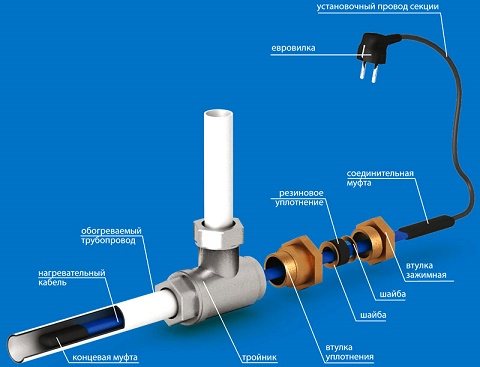

For the installation of the internal cable, you may need a clamping and sealing sleeve, a joint sleeve, a set of washers, and other elements (+)
To install the inner cable into the completed pipe, you will first need to cut a tee into the system. This will make a hole for inserting the cable into the pipeline.
In addition, a special nipple sleeve may be required. Such a solution may slightly worsen the characteristics of the sewer system, for example, at the point where the tee is installed, the pipe clearance will slightly decrease.
This increases the likelihood of debris accumulation and blockages. Difficulties with the internal cable are inevitable if the pipeline has several bends, bends, etc. It is not easy to carry out internal work on the installation of a hot cable, as well as in sewer systems of considerable length.
Of course, you should not connect the system to the power supply until the installation work is complete. Before covering the cable with insulation, you should carefully check all the connections. If you use thermal sensors, it will be easier to determine when the system is activated and deactivated.
You can automate the process using a relay. If the power of the cable laid in one line is not enough, you can perform a spiral installation or lay two parallel lines. The main thing is that individual sections do not intersect, and there is no overheating. To make the heating of the structure more uniform, sometimes the pipe is first wrapped in foil, then a cable is placed on top.
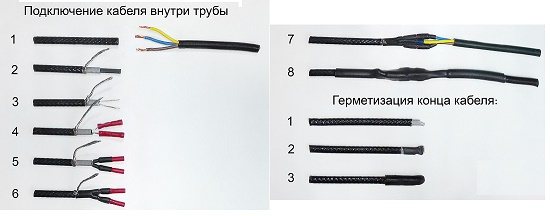

These examples allow you to get an idea of how to correctly connect the supply and heating cable, as well as the order of its insulation (+)
Temperature sensors are installed after the insulation is supplied. Above it is recommended to apply markings that reflect the position of the heating elements. To connect the heating cable to the mains, you will need a piece of heat-shrinkable pipe. Then, about 50 mm of insulation and 10 mm of braid are removed from the edge of the cable.
The separated and stripped ends are protected with pieces of heat-shrinkable tubing of a suitable diameter and heated with a hairdryer. Now you need to strip about 6 mm of the wires, turn them into a spiral and clamp them in a metal tube. Similar manipulations will have to be done with the power cable.
About 80 mm must be stripped of insulation and sheathing and divided into separate wires. The resulting ends are trimmed to 35 mm, but one wire should be left uncut for grounding. 6 mm wires are also stripped here.
The ends of the heating elements and power cables are now connected in a heat shrink tubing fitted with a metal sleeve. It is heated and clamped, the place of contact is wrapped with thermal tape, and then closed with another protection tube.
The following article will acquaint you with the features of the choice of pipes directly for the device of an autonomous sewage system, with the content of which we advise you to familiarize yourself.
Types of pipes that should be heated
It may be necessary to heat such sewer pipes:
- external sewerage systems - for draining wastewater to treatment plants or septic tanks;
- pipes connecting the septic tank with drainage fields or a well for filtration;
- for the drainage of rinsing water from cleaning filters.
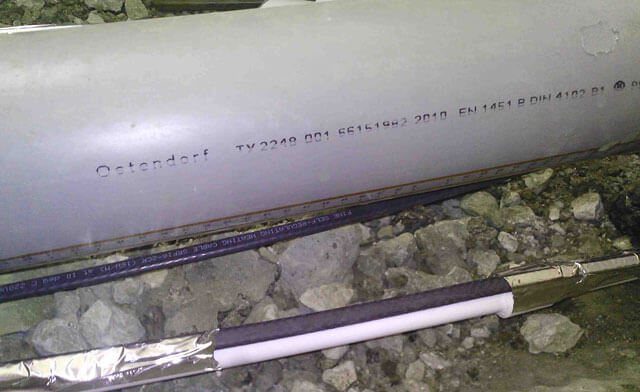

As a rule, insulation is carried out by wrapping with thermal insulation, providing an air gap and in other ways (in more detail: "How to insulate sewer pipes in the ground - materials and methods of insulation with your own hands"). The latest technologies can offer more convenient ways to heat sewer pipes - a heating cable that can be laid both outside and inside the pipe. In addition, there are elements of engineering communications on sale that already have a ready-made heating system. These are sandwich pipes and self-heating cables.
Naturally, the method of heating sewer pipes with a heating cable cannot be called cheap. But since such a system will work without interruptions for a very long time in any frost, you can put up with additional costs. After all, it cannot be ruled out that the pipe will simply burst without heating, and even more funds may be required to fix the problem.
Types of pipes to be heated
It is necessary to establish heating of sewer pipes with your own hands, if they pass over the surface, are located in unheated basements or at a shallow depth in the ground.
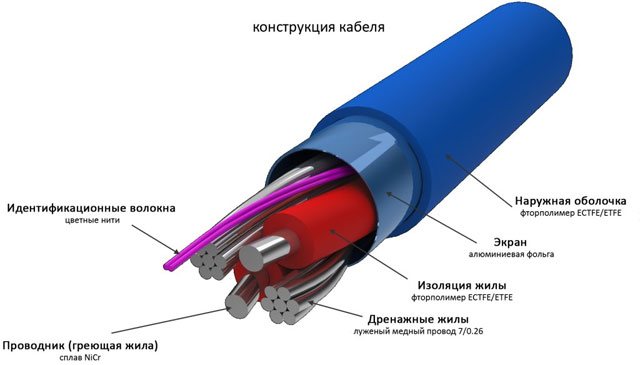

In need of constant winter heating:
- External sewerage (at the exit from the house) and laid above the level of freezing of the soil. Pipes leading to the receivers of treatment systems. Connecting pipes of multistage septic tanks. Flushing outlets of filters. Waters for sewage treated by a septic tank directed to the aeration field.
Fixing the heating cable to the pipe
If freezing occurs in the pipe at any of these stages, the ice plug will block the passage and the system will stop working. Then you will have to look for where the problem arose, and master the emergency heating of pipes with a cable with your own hands.
External heating systems
Due to the ease of installation and low cost, the film method of heating the sewer pipe with your own hands is considered quite popular. The installation process of such a system is very simple - wrap the pipes with foil and fix it with tape or clamps.
But the cable for heating sewer pipes from the inside and outside is still more popular, and every day the demand for it is growing more and more. This method involves laying the cable along the entire length of the pipeline. After starting the system, it will be fully warmed up to the required temperature.
At the moment, the following heating cables are manufactured:
Self-adjusting. According to experts, this type of heating cable is the most efficient and practical from an economic point of view. Its peculiarity lies in the mechanism of work.
The fact is that such products react to temperature fluctuations in the air. This means that as the ambient temperature rises, the cable resistance decreases significantly, therefore, the current strength also weakens, which means that the power also decreases.The principle of operation of the device is laid down in the formula P = U × I, where I is the current strength, U is the resistance, and P is the power of the cable.
Such a mechanism can significantly reduce energy costs and make them more reasonable. The technology for the production of heating cables allows you to regulate the power at different sections of the pipeline, which is quite important due to the constant rise in electricity prices. Products of this type are distinguished by the stability of resistance along the entire length of the laid line.
Consequently, the amount of thermal energy emitted by such a cable is the same at any section. In essence, such a cable works similarly to a resistive cable, however, the generation of heat energy occurs in specific areas. Thanks to such a device, the zone heating cable in the sewer pipe can be cut into pieces and the load can be distributed at your discretion.
By and large, all these cables work in about the same way, the only difference is in the features of their installation and use.
Resistive cables can vary in structure:
Single core cable. As the name implies, it consists of one core through which current flows.
It is also a heating element and is protected by a layer of insulation, a braid made of shielding material, as well as an outer sheath. Laying cables of this type is done in loops so that both ends converge in one place to connect to the network. Please note that a single core cable is not used for installation inside pipes.
This is due to the fact that if the cable sections overlap, it can overheat and burn out. In this case, one of the conductors, the resistance of which is greater, serves as a heating element, and the second conductor only conducts current. Therefore, to wind both ends of the cable at one point - there is no need, the return conductor serves for this purpose.
Please note that you need to choose one or another type of cable based on the expected conditions of its operation.

